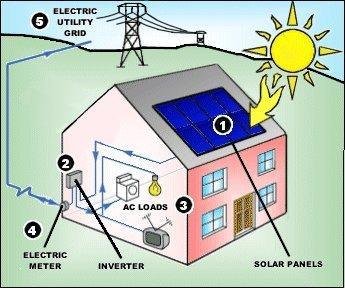Solar Electric
The sun produces energy through nuclear fusion – Every minute enough of the suns energy reaches the earths surface to meet the planets energy demands for an entire year.
- Solar Panels absorb the suns energy and convert the light energy into electrical energy (Direct Current) and through wires the electricity flows to the inverter
- The Inverter converts the electricity into AC (alternating current) so it can be used by household appliances and lighting.
- AC loads will use the energy produced by the solar panels – excess energy will be sent to the electric utility
- The electric meter measures the amount of electrical energy the Solar panels produce – giving owner credit for any energy returned to the utility company
- The electric utility grid acts a storage medium for excess electricity
There are three types of photovoltaic systems
- Grid tied systems which use utility lines instead of batteries: This system is designed to efficiently reduce your electric bills and qualifies for incentives, grants and State and Federal tax credits. These systems are typically “net metered”. This means you are credited at the retail electric rate for any power fed back into the utility grid.
- Battery backup systems for emergency power; These can also be grid tied and “net metered” and also qualifies for incentives, grants and tax credits. These systems will continue to power your essential loads in the event of a power outage
- “Off Grid” or “Stand Alone” systems which are independent of the power lines; These systems are usually installed where it is too expensive for power line extensions. These systems are ideal for cabins and week end retreats. Many of our customers are happily living off grid
“I’d put my money on the sun and solar energy. What a source of power! I hope we don’t have to wait until oil and coal run out before we tackle that.”

